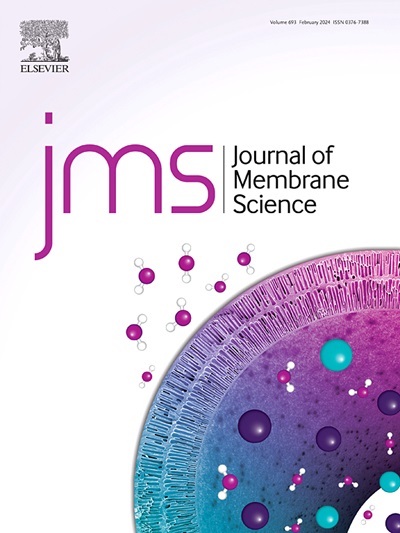通过uv触发与光催化MOF集成的自清洁PDMS膜
IF 8.4
1区 工程技术
Q1 ENGINEERING, CHEMICAL
引用次数: 0
摘要
光催化优势混合基质膜已成为提高分离性能和解决膜污染的一种很有前途的策略。然而,光催化剂在聚合物基体中的均匀分散和在工业规模上的可扩展性仍然是一个巨大的挑战。光催化剂的局部团聚不仅会降低降解效率,还会产生影响膜分离性能的结构缺陷。在这项工作中,为了解决这些问题,开发了一种简单的紫外触发光催化圆盘状MOF和聚二甲基硅氧烷(PDMS)的集成设计,实现了高性能自清洁纳滤(NF)膜的快速(3分钟)和可扩展制造。紫外触发的硫醇- pdms与甲基丙烯酸酯修饰的聚偏氟乙烯基质之间的硫醇-烯反应锚定了MOF,从而抑制了团聚。这种快速的光聚合方法使光催化剂均匀分布,同时确保放大膜制造。结果表明,实验规模和工业规模的膜均具有优异的纳滤性能,其透水性为85.73 L m−2 h−1 bar−1/75.79 L m−2 h−1 bar−1,刚果红去除率为99.08% / 97.73%,工业规模的膜在不影响选择性的情况下具有可扩展性。此外,在阳光照射下,其优异的分离性能可以在5个周期内恢复,表面没有可检测到的染料残留,这表明圆盘状MOF与衬底之间具有强大的结合。为了更好地理解染料的自清洁过程,提出了染料的光催化降解机理。该研究为高性能、自清洁和工业规模的纳滤膜的制备奠定了基础,为可持续废水处理技术的发展提供了新的前景。本文章由计算机程序翻译,如有差异,请以英文原文为准。

Self-cleaning PDMS membranes via UV-triggered integration with photocatalytic MOF
Photocatalysis dominant mixed matrix membranes have emerged as a promising strategy for enhancing separation performance and solving the membrane fouling. However, the uniform dispersion of photocatalysts within the polymeric matrix and scalability in industrial-scale implementations are still great challenges. The localized agglomeration of photocatalysts not only diminishes degradation efficiency but also generates structural defects that impair membrane separation performance. In this work, a facile UV-triggered integration design of photocatalytic disk-shaped MOF and polydimethylsiloxane (PDMS) was developed to address these issues, enabling rapid (3 min) and scalable fabrication of high-performance self-cleaning nanofiltration (NF) membranes. The UV-triggered thiol-ene reaction between thiol-PDMS and methacrylate-modified polyvinylidene fluoride substrate anchored MOF, thereby suppressing agglomeration. This rapid photopolymerization approach enables uniform distribution of photocatalyst while ensuring scale-up membrane fabrication. Results show that both lab-scale and industrial-scale membranes have superior NF performance with water permeance of 85.73 L m−2 h−1 bar−1/75.79 L m−2 h−1 bar−1 and Congo Red rejection of 99.08 %/97.73 % and the industrial-scale membrane demonstrates scalability without compromising selectivity. Furthermore, their excellent separation performance can be recovered over five cycles under sunlight irradiation with no detectable dye residues on the surface, suggesting the robust bonding between disk-shaped MOF and substrate. The photocatalytic degradation mechanism towards dye is also proposed to well understand the self-cleaning process. This work could establish a strategy for fabricating high-performance, self-cleaning and industrial-scale NF membranes, offering new perspectives for sustainable wastewater treatment technologies.
求助全文
通过发布文献求助,成功后即可免费获取论文全文。
去求助
来源期刊

Journal of Membrane Science
工程技术-高分子科学
CiteScore
17.10
自引率
17.90%
发文量
1031
审稿时长
2.5 months
期刊介绍:
The Journal of Membrane Science is a publication that focuses on membrane systems and is aimed at academic and industrial chemists, chemical engineers, materials scientists, and membranologists. It publishes original research and reviews on various aspects of membrane transport, membrane formation/structure, fouling, module/process design, and processes/applications. The journal primarily focuses on the structure, function, and performance of non-biological membranes but also includes papers that relate to biological membranes. The Journal of Membrane Science publishes Full Text Papers, State-of-the-Art Reviews, Letters to the Editor, and Perspectives.
 求助内容:
求助内容: 应助结果提醒方式:
应助结果提醒方式:


